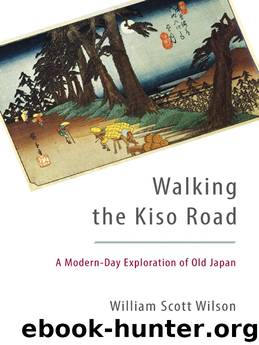Walking the Kiso Road by William Scott Wilson

Author:William Scott Wilson
Language: eng
Format: epub
Publisher: Shambhala Publications
A NUMBER OF YEARS LATER, I was back in the Kiso and once again staying at the Sarashina-ya. There was a knock on the door of my room announcing dinner, but rather than Mineko, it was her husband, Ando-san. (Mineko has explicitly requested that I call her by her given name; Ando-san is a bit more reticent and shy and prefers his family name.) Dinner was ready, he said, but added that sometime later there would be a service at the local Ontake-kyo temple and asked if I would like to attend. He himself, although a shaman, would be unable to enter the temple as his second granddaughter had just been born, making his presence taboo. I assured him that I would be more than pleased and followed him down to the dining hall.
The dining room was crowded that night, so for convenience’s sake, Mineko had put me at the same table as the only other foreigner there, a fiftyish man from the States. As we talked over dinner, he informed me that he was a travel writer and was preparing an article on the Kiso area. Although he spoke almost no Japanese and seemed to be picking at the local food, he was gamely following parts of the Nakasendo, so I quickly let him know about the service at the temple and encouraged him to come along. He was not particularly enthusiastic, but I persisted, and, after our repast, we found ourselves in Ando-san’s car, heading toward the temple on the outskirts of the post town. Soon, we were dropped off at the entrance to the temple, our gracious driver telling us that he would pick us up at the conclusion of the service.
The Hyakumataki temple is a wood and clay structure with a gray tiled roof, and not very large—certainly not as large as some of the more elegant Zen and Shin temples that dot the Nakasendo. Inside, cushions were set on the floor for perhaps forty to fifty people at the most and, facing these, a platform on which, this evening, along with two huge dark wooden statues of the men who “opened” the mountain, was a very large polygonal stack of cedar planks, each about a foot and a half long and an inch and a half square. Above this stack of planks hung the holy white folded papers indicating the sacred in the Shinto religion.
As we all entered the temple, we were each given a white jacket to symbolize purity of mind and a cedar plank of our own. This would be an o-harai, a ceremony of cleansing. My American acquaintance and I were ushered to the front row of cushions, on each of which was a booklet of sutras written in Sino-Japanese that would be chanted throughout the ceremony. Soon, when the last of the congregation had been seated, a white-robed priest and his attendants mounted the platform, and the chanting began. At first only the priest chanted, his attendants blowing conch shells and
Download
This site does not store any files on its server. We only index and link to content provided by other sites. Please contact the content providers to delete copyright contents if any and email us, we'll remove relevant links or contents immediately.
Asking the Right Questions: A Guide to Critical Thinking by M. Neil Browne & Stuart M. Keeley(5649)
Autoboyography by Christina Lauren(5184)
Eat That Frog! by Brian Tracy(4436)
Dialogue by Robert McKee(4323)
Sticky Fingers by Joe Hagan(4103)
Journeys Out of the Body by Robert Monroe(3572)
Annapurna by Maurice Herzog(3424)
Full Circle by Michael Palin(3389)
Schaum's Quick Guide to Writing Great Short Stories by Margaret Lucke(3321)
Elements of Style 2017 by Richard De A'Morelli(3307)
The Art of Dramatic Writing: Its Basis in the Creative Interpretation of Human Motives by Egri Lajos(3017)
Atlas Obscura by Joshua Foer(2900)
The Diviners by Libba Bray(2887)
Why I Write by George Orwell(2877)
In Patagonia by Bruce Chatwin(2876)
The Fight by Norman Mailer(2848)
The Mental Game of Writing: How to Overcome Obstacles, Stay Creative and Productive, and Free Your Mind for Success by James Scott Bell(2845)
Venice by Jan Morris(2526)
The Elements of Style by William Strunk and E. B. White(2442)
